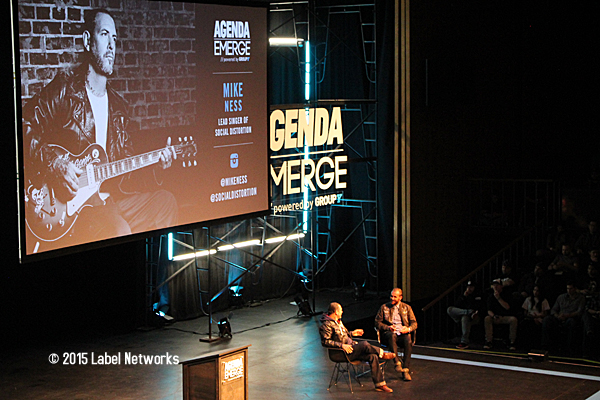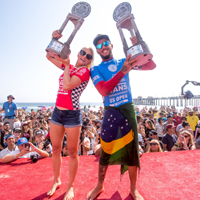
The 4th Annual Agenda Emerge powered by Group Y held in Long Beach, CA, January 6, 2015, was the biggest conference yet for the action sports and streetwear industries. With a capacity crowd of 825, it was clear that people were interested in hearing how innovation and creativity can produce the most amazing brands, bands, and art.
“The heart of Agenda Emerge is the young and inspired minds of a new generation,” said Agenda Founder, Aaron Levant. “Going head to head with the largest well-established fashion industry shows and watching these brands reach success, knowing that we had a hand in it, has been a humbling journey. This is a great opportunity for the new generation of designers to learn from seasoned experts who have turned their brands into household names.”
The conference took place after the closing of the Agenda trade show, and offered the perfect timing for the tribes to get together and network at the conference. The main attractions of course were the speakers, which Group Y founder Mark Sperling, and others, did a great job at congregating. They included Bob Hurley, founder of Hurley, Rob Hurley, his son and the creative director of Hurly, C.R. Stecyk III, co-founder of Juxtapoz, artist, writer, Lyndon Cormack, co-founder of Herschel Supply Co., Mike Ness, singer and guitarist of Social Distortion, Shepard Fairey, street artist and founder of Obey and Studio One, and Tinker Hatfield, VP of Innovation and Creative Concepts at Nike.
While all of the presenters shared insightful stories about their journeys in creating their brands and concepts, the key theme throughout was don’t give up on the creative impulse you may have. Being different isn’t necessarily a bad thing, and thinking outside of the box is essential.

The best speaker was Shepard Fairey who relayed the epic story of his journey as a sticker and T-shirt screen print artist and the launch of Obey and Andre the Giant. Instead of being attracted to the museums during a NYC field trip during school at the Rhode Island School of Design, he found himself more attracted to the street art of the gritty subways and streets of the city which told a different story.
Shepard also pointed out that Andre the Giant and the whole “posse” campaign started as an insider joke. But it also represented the fact that advertising is the greatest propaganda. The styles and colors that are signature Fairey have influence from Russian constructive propaganda. There’s no doubt that the creative energy behind Fairey’s work tends to stem from political misgivings and counter culture roots. In every way, Fairey is inspired by his punk rock aesthetic. Just as easily as talking about the atrocities and bad judgment for war in Iraq, or working on relief efforts in Haiti, he’s the only guy I know of that can also incorporate bands like Public Enemy, Black Flag, and Sex Pistols within conversations of art and global atrocities.
Fairey also relayed that his clothing, especially T-shirts, are the canvases of his causes. “Clothing relates to all of us. There’s a ripple effect, and things like T-shirts are the gateway to culture.” Fairey produces 60-80 graphic T-shirts per year, but stays to his roots of painting giant murals in a number of cities every year as well. The physical and mental planning for the creative production of street art is clearly where his heart is.

C.R. Stecyk III is also a talented speaker. The only complaint during this conference would be that Ryan Hurley, who moderated most of the presentations, should have just stepped aside when it came to Stecyk and let the OG of art and surf and skate culture tell his story without interruption. Fortunately, I’ve had the privilege to interview Stecyk as well, and you can tell he is a smart man who’s artistic endeavors with art, photography, and film have a purpose twisted in with a dry sense of humor that only comes from living through the urban detritus of a crumbling environment.
Stecyk happened to grow up near Ocean Park, the end of the legendary Route 66. His father had photo and film equipment from working as a war journalist during World War II. Combined with a ceramicist, mother, you can see how Stecyk was equipped with the tools of the trades for art and media. At the time, the area was a crumbling landscape of a circus no longer in use. Pilings in the ocean that once held proud piers were now the pillars for legendary local hardcore surfers to shoot through, and when the waves sucked, they took to the streets and started the sport of skateboarding. Stecyk captured the culture which made skateboarding and the guys in it, legendary, as Stacey Peralta’s “Dogtown and the Z-Boys” documentary proved.
Stecyk is the Captain Hook of skate and surf art and media and carries with him legendary status like no one else in the industry. You can’t get any more authentic than him and he’s in demand often for various artistic collaborations to give cred to brands that use him. (Hurley did a collaboration with Haze and Stecyk which was showcased at the Agenda show.)
Tinker Hatfield came from an architecture background, but moved into designing some of the most epic sneakers for Nike ever, including the Jordan series, Air Max 1, and others. His inspiration came from viewing the Pompidou in Paris, which when it was built from 1972-76, was very controversial. The building looks modern, and it looks like it is inside-out because you can see the pipes, staircases, and steel beams. Hatfield took the concepts of the Pompidou and thought about designing a sneaker where you could see the inside workings of the shoe. In the end, it’s always inspiring to see how things evolved and where the inspiration for creativity comes from. Footwear from architecture is unique. He also spilled the beans that Nike was working on a revival of the “Back to the Future 2” self-lacing sneaker that Hatfield made for Michael J. Fox’s character in the 80’s.

Mike Ness from Social Distortion got the greatest applause, which makes sense. The guy is a gifted musician and has been through a lot in his hardcore punk rock life. He expressed the story of finding solace and a “safe place” at his elderly babysitter’s room which was covered with religious art and included a big old radio. Growing up in an alcoholic family, music, especially punk rock, was his escape and he made the most of it, even through years of doing odd jobs like house painting. As he put it, whenever anyone said “you can’t do it, it just fueled the fire.”
“The Sex Pistols,” expressed Ness, “sounded like what you felt like. And anyway, we were only supposed to live to 30.”
That concept of living your life as full as possible is a huge part of action sports and streetwear which come from roots of necessity mixed with a huge doses of music. As Ness said, “Music taps into that human emotion. It is the only thing that is universal.”
This is something we have said often when consulting with brands and organizations when it comes to youth culture. Music is the universal language and the connector across genders, ages, ethnicities, and economic levels of all kinds. Hearing it from Mike Ness in a passionate presentation revived the message.

Lyndon Cormack launched the conference with a humbling story of how he and his brother took the concept of creating a well-designed backpack from it’s infancy of an idea, named after his grandfather’s tiny village in Saskatchewan, Canada, to becoming the well-respected, classic international bag and apparel company that it is today. Lessons from his presentation stem from having the perseverance to figure out how to make your own company, and that relying on your own hard work (and a bunch of Google searches) is how it happens.
Bob Hurley, moderated by his son Ryan, was an interesting presentation on the growth of a brand starting from being at the right place at the right time. In Hurley’s case, it started with wanting to make the best surfboard, living in Huntington Beach. CA, a.k.a. Surf City, and making boards for pros like Rabbit Bartholomew. While everyone knows that Hurley was the guy behind growing Billabong into a multi-million dollar company, he didn’t go into it that much and instead, chose the path of how he made his own brand, Hurley, into what it is today.
Of course, the aspect missing from the Agenda Emerge conference was a female speaker. Someone like Sophia Amorusa for example, the founder of NastyGal.com would have been a great fit, or Caledonia Dance Curry, a.k.a. Swoon. But the majority of the audience at this conference reflected the bro-nature of the Agenda show itself which tends to skew high on the guy side.
However overall, the 4th Annual Agenda Emerge conference was a huge success and paved the way for a greater variety of educational and inspiring conferences around the industries of art, music, streetwear, and action sports for the future.


